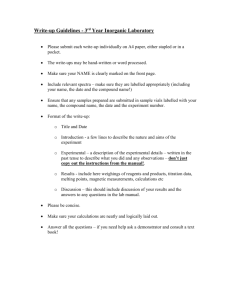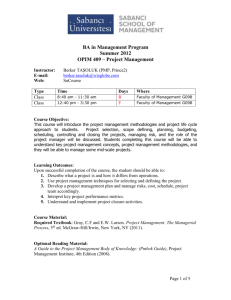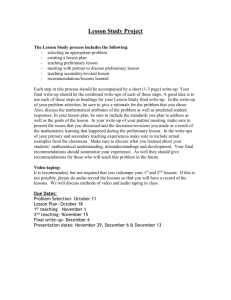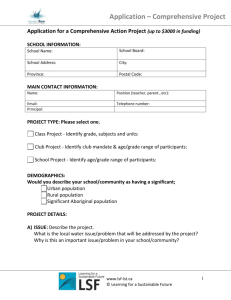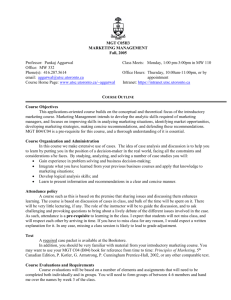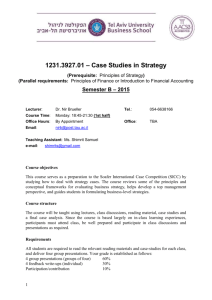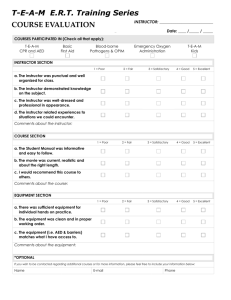OPIM319_SubrataPal
advertisement
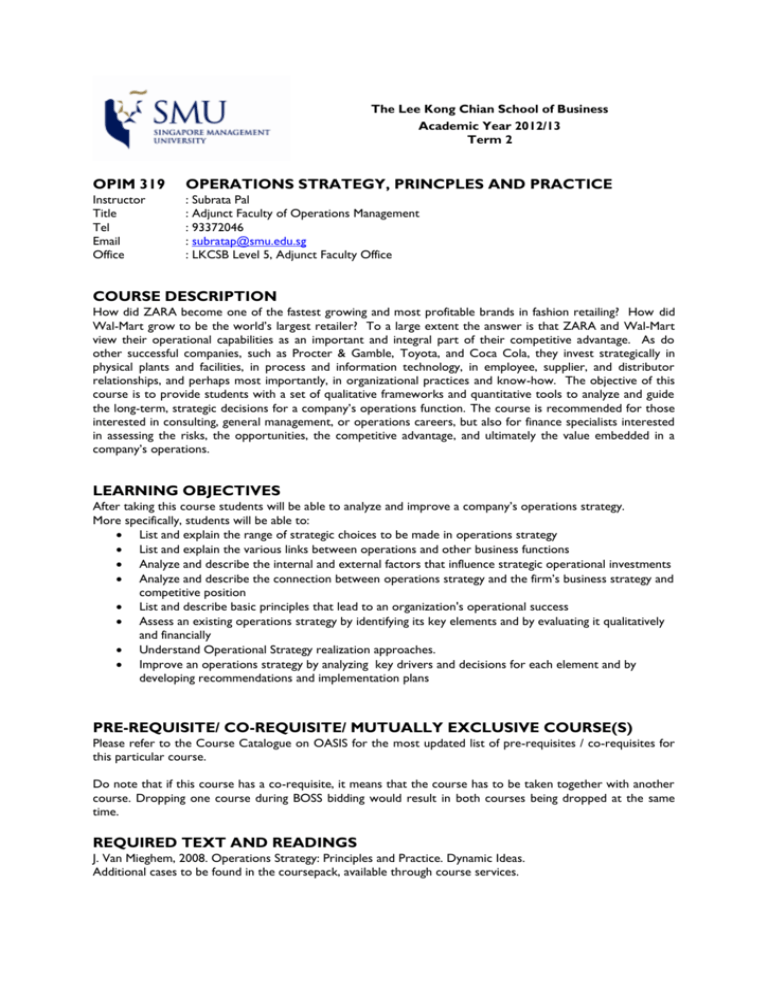
The Lee Kong Chian School of Business Academic Year 2012/13 Term 2 OPIM 319 OPERATIONS STRATEGY, PRINCPLES AND PRACTICE Instructor Title Tel Email Office : Subrata Pal : Adjunct Faculty of Operations Management : 93372046 : subratap@smu.edu.sg : LKCSB Level 5, Adjunct Faculty Office COURSE DESCRIPTION How did ZARA become one of the fastest growing and most profitable brands in fashion retailing? How did Wal-Mart grow to be the world’s largest retailer? To a large extent the answer is that ZARA and Wal-Mart view their operational capabilities as an important and integral part of their competitive advantage. As do other successful companies, such as Procter & Gamble, Toyota, and Coca Cola, they invest strategically in physical plants and facilities, in process and information technology, in employee, supplier, and distributor relationships, and perhaps most importantly, in organizational practices and know-how. The objective of this course is to provide students with a set of qualitative frameworks and quantitative tools to analyze and guide the long-term, strategic decisions for a company’s operations function. The course is recommended for those interested in consulting, general management, or operations careers, but also for finance specialists interested in assessing the risks, the opportunities, the competitive advantage, and ultimately the value embedded in a company’s operations. LEARNING OBJECTIVES After taking this course students will be able to analyze and improve a company’s operations strategy. More specifically, students will be able to: List and explain the range of strategic choices to be made in operations strategy List and explain the various links between operations and other business functions Analyze and describe the internal and external factors that influence strategic operational investments Analyze and describe the connection between operations strategy and the firm’s business strategy and competitive position List and describe basic principles that lead to an organization's operational success Assess an existing operations strategy by identifying its key elements and by evaluating it qualitatively and financially Understand Operational Strategy realization approaches. Improve an operations strategy by analyzing key drivers and decisions for each element and by developing recommendations and implementation plans PRE-REQUISITE/ CO-REQUISITE/ MUTUALLY EXCLUSIVE COURSE(S) Please refer to the Course Catalogue on OASIS for the most updated list of pre-requisites / co-requisites for this particular course. Do note that if this course has a co-requisite, it means that the course has to be taken together with another course. Dropping one course during BOSS bidding would result in both courses being dropped at the same time. REQUIRED TEXT AND READINGS J. Van Mieghem, 2008. Operations Strategy: Principles and Practice. Dynamic Ideas. Additional cases to be found in the coursepack, available through course services. ASSESSMENT METHOD Class Participation: Group Case Write-Ups: Group Project: Group Contribution (peer review): Final Examination: 15% 20% 25% 10% 30% ACADEMIC INTEGRITY All acts of academic dishonesty (including, but not limited to, plagiarism, cheating, fabrication, facilitation of acts of academic dishonesty by others, unauthorized possession of exam questions, or tampering with the academic work of other students) are serious offences. All work presented in class must be the student’s own work. Any student caught violating this policy may result in the student receiving zero marks for the component assessment or a fail grade for the course. This policy applies to all works (whether oral or written) submitted for purposes of assessment. Where in doubt, students are encouraged to consult the instructors of the course. Details on the SMU Code of Academic Integrity may be accessed at http://www.smuscd.org/resources.html. COURSE METHODS Each topic will be discussed using a combination of models, exercises, case-discussions, and readings. The anticipated mix for the course is 50-50 qualitative-quantitative. In a typical week we will cover one major case in-depth, supplemented by mini-lectures and qualitative discussions of other examples. CLASS SCHEDULE Week 1 Topic Framework for Operations Strategy Readings Ch. 1 2 Competition, Competencies and Operations Ch. 2 3 Capacity Sizing and Investment Ch. 3, ACC 4 Capacity Timing and Expansion Ch. 4, Harley Davidson (Ch.11) 5 Capacity Location, Global Networks and Offshoring Ch. 6, Mini-case 4 6 Capacity Types, Flexibility, and Consolidation Ch. 5, Eli Lilly 7 Project Progress Discussions 8 Recess 9 Strategic Sourcing and Supply Management Ch. 7 10 Operations Planning and Strategy Realization Class notes, Zoom Scoot Case 11 Strategic Information Systems B&R Ch. 9, Moore Medical 12 Operational Excellence and Continuous Improvement Ch. 10 and BR Ch 10 ITT 13 Project Presentations OPIM 319 Operations Strategy 2 ASSESSMENT METHOD DETAILS Class participation (15%): Class participation depends on your presence in the classroom, your perceived preparation, and the contribution you make to the learning experience of others. Class participation includes in-class questions to the instructor, insights and/or comments regarding class content, answers to the instructor’s in-class questions, and reactions to other students’ in-class contributions. The quality of in-class participation will strongly depend on your preparation: reading the case and assigned articles or book chapters and preparing answers to the preparation questions referred to in the class schedule (see below). Cold-calling (direct questions by the instructor to an individual student during a class session) will be used to check class preparation and will usually involve the preparation questions. Please leave your name-card up for the entire duration of each class and keep the same seat for the duration of the quarter. (Although cold calling may increase anxiety, education experts suggest that ―supportive‖ cold calling encourages you to be better prepared for class and as a result improves the overall class discussion.) A thorough preparation of the assigned materials is all that is necessary for such leadoff questions. If you feel uncomfortable with being called on in class please let me know in advance so that we can agree on an alternative mode of interaction. Email your key inputs that you shared in the class to the instructor after the class. Group Case Write-ups (20%): There are three case write-ups to be handed in Each group will consist of five students. You will receive a group grade but if there is a clear reason to do so I may upgrade or downgrade certain individuals in the group. Case write-ups have to done within your group; collaboration with other groups is not allowed HONOR CODE FOR SUBMISSIONS: cases may not be discussed with anyone outside your group nor may you use other sources without acknowledgment. It is important that everyone has a level playing field so this also means that materials from previous years or websites cannot be used. I'm sure you understand. To count towards your grade a hard-copy of the case write-up needs to be handed in at the start of the session in which the case is discussed. E-mails will not be accepted. The case write-ups are to be no longer than 2 pages excluding exhibits (tables, charts, figures, diagrams) and need to contain answers to a set of preparation questions for that case. The preparation questions for the cases are given in the detailed class schedule below. Usually, the case will prompt you to make a recommendation for the company in question. Start your case write-up with a short summary (less than 250 words) that describes the situation of the company, the problem it is facing, the question it needs to answer and your recommendations. Then support this recommendation with a detailed analysis that needs to contain answers to the preparation questions for the case. Grading criteria include: clarity and completeness of summary, quality of the answers to preparations questions, appropriate and sufficient use of case facts where needed, apparent grasp of course concepts as well as logic and structure of the write-up. OPIM 319 Operations Strategy 3 Group Project (25%) The group project is an opportunity to apply course concepts and to perform an in-depth analysis of operations strategy issues that are of interest. Each group will consist of five students. Your group is the same as for the case write-ups. Expected time commitment per team member is 20-30 hours You will receive a group grade but if there is a clear reason to do so I may upgrade or downgrade certain individuals in the group. The Project Report will determine 70% of the grade. Grading criteria include: o Thoroughness and comprehensiveness of investigation o Quality of the report logic, structure, style, clarity, grammar, spelling, layout o Creativity displayed in study o Knowledge and insights displayed in work, as related to the area of Operations Strategy o Usefulness of the project’s guidelines or recommendations The remaining 30% of the grade is determined by the Project Presentation. The grading criteria include: o Effectiveness of the presentation by team members o Effectiveness of the presentation slides o Ability to answer questions effectively HONOR CODE FOR GROUP PROJECT: You should make very clear what part of your project report and presentation is based on your own thinking and what part summarizes pre-existing outside sources. It is extremely important and part of the honor code that you explicitly identify and cite all significant external sources that you build on in your report. This applies in particular to papers you may have written for other SMU classes, to documents you may have received from the company you are analyzing, interviews with industry experts, etc. Building on external sources is by no means a ―bad thing‖–solid work is typically aware of and builds on what others have done. Ideally though, you should take this external information and add the filter of your own critical thinking and the concepts studied in this class to synthesize it, critique it, etc. Please read the Guidelines for Group Project later in this syllabus. Group Contribution (10%) The group contribution component will be evaluated by peers in your group. Your peers will assess your contribution to the group case write-ups and the group project. The assessment criteria will include effort, team spirit, initiative, work quality, knowledge and ideas. Final Examination (30%) The final exam is to be done individually, in class, closed-book. The questions will relate to the class readings and the materials presented by the instructor in the class sessions. The primary objective of the exam is so that you will review and synthesize the content of the course. The final exam will be administered during the regular exam period. OPIM 319 Operations Strategy 4 GUIDELINES FOR GROUP PROJECT You can choose from two possible types for your group project (see sample outlines below): 1. ―Case study‖: Identify an organization (one familiar to you or your group would work well) whose operations strategy you can analyze and improve, or 2. ―White paper‖: A research-oriented paper on a specific topic in operations strategy or a novel practice in industry that directly relates to operations strategy. The paper describes risks, benefits and best practices along with industry examples of each. KEY EXPECTATIONS: The project has a strong operational component The project is interesting and has a general learning point. Aim for a project in which not only you, but also your audience, will learn something new. The analysis uses or extends concepts discussed in class Option 1: case study of specific organization Identify an organization (one familiar to your group would work well) where you can test and extend issues in operations strategy. Examples of such projects include: capacity expansion at a local service or manufacturing company, improving customer service at a Hospitals’s specialized clinic, sourcing and production planning at a high-speed garage door manufacturing plant, customer service strategy at a high-end hotel chain investment in information technology at a logistics company FORMAT: The maximum length is 8 pages of text, and maximally 4 pages of supporting exhibits. Your Project Report should be in the form of a mini case, consisting of three parts: 1. Executive Summary (no longer than 250 words); use the following structure: Situation (what is the background situation/context for your report) Complication (what in this situation/context leads you to do your investigation) Question (what is the question you will try to answer in your report) Answer (a summary of the answer you have come up with in your investigation, i.e. your main findings and recommendations) 2. The actual case (similar to the cases you typically read; max 4 pages): Describe your unit and its competitive identity and environment. Describe the organization’s current business strategy. Describe the operating strategy, its competencies (in terms of cost, time, quality, and flexibility), activity network (process view) and asset bundle (resource view). Describe the strategic issues and challenges. Provide data (the best cases stand out because they support their recommendations both qualitatively and quantitatively) 3. Your analysis and recommendation (similar to the write-up you typically do; 4 pages max). This should not be a detailed description of everything you have done but a specific set of observations and recommendations. Evaluate the strengths and weaknesses of the current operations strategy using course concepts Identify + analyze potential improvements Recommend an improved strategy that addresses the issues and challenges. Discuss implementation steps. Option 2: white-paper on a specific issue or practice in operations strategy Identify and analyze a current issue or novel practice in operations strategy. Imagine you work for a consulting company and you need to inform your clients about this current issue or novel practice. Examples of such projects include: OPIM 319 Operations Strategy 5 Survey of contemporary approaches to build flexible capability: use of modular facilities in pharmaceutical industry, platform strategies in the automobile industry, a study of the operations strategy for retail banking, capacity options in the airline freight industry, operations strategy issues in a specific industry. FORMAT: The maximum length is 8 pages of text, and maximally 4 pages of supporting exhibits. Your Project Report should contain: 1. Executive Summary (no longer than 250 words); use the following structure: Situation (what is the background situation/context for your report) Complication (what in this situation/context leads you to do your investigation) Question (what is the question you will try to answer in your report) Answer (a summary of the answer you have come up with in your investigation, i.e. your main findings and recommendations) 2. A description of the operations strategy issue or practice 3. Major benefits of the practice. 4. Major risks/cost of the practice 5. Key issues in designing and implementing the practice 6. Which companies is this practice ideally suited for? Which companies may it not be suitable for? 7. Examples of companies that are successfully using the practice. 8. Examples of companies that have been unsuccessful in their implementation of the practice and possible reasons (if you can find examples). OVERALL FINAL PROJECT REQUIREMENTS 1. Week 4: Submit Project Proposal in class. The project proposal is a one page document that outlines Project title + indicate whether case study or white paper A preliminary version of the executive summary of the project (use placeholders/boilerplates where you do not yet have findings) Relationship to class topics: specify which operations strategy topics your project will relate to Contact person at related organization who has agreed to cooperate with project (for case study) Timeline of project activities (this will be your project plan) Team member roles 2. Week 7: 2 days prior to class, email a Preliminary Project Report to the instructor. A preliminary project report will use the structure of the final report but will obviously still have some ―holes‖ in it, areas where more work needs to be done. Be sure to include an updated version of your executive summary, and right after that a project update section that includes: Progress assessment on the timeline of project activities – show where you are on track and where you have delays Description of project difficulties and how you plan to tackle them. The class session for week 7 will be dedicated to a discussion of your Preliminary Project Report. Each group will be scheduled for a 15 minute in class conference. 3. Week 13: Hand in a hard-copy of your group’s Project Report in class and be prepared for a 15 minute in-class Project Presentation (10 minutes to present, 5 minutes for questions and answers). At least two group members need to present. There is no limit on how many group members present. Dress code for the presentation is business attire. OPIM 319 Operations Strategy 6 DETAILED CLASS SCHEDULE Week 1: A Framework for Operations Strategy Content: What is operations strategy? Introduce a framework to describe a company’s operations strategy. The key premise is that an operations strategy must be evaluated in terms of the performance it delivers. This performance depends on the activity network and the asset bundle that operations puts in place. We will discuss the goal of operations strategy and a framework to think about operations strategy. We will use the Swiss Watch Industry short case as the main vehicle to introduce the framework. Read: Chapter 1: ―Operations Strategy: Concept and Framework‖ Swiss Watch Industry, mini-case 1 in Chapter 1. Be prepared to discuss the accompanying questions. Week 2: Competition, Competencies and Operations Content: Read: Discuss how the concepts of operational trade-offs and competency focus relate to strategic positioning and operational efficiency and how they can be used--qualitatively and quantitatively—to evaluate a firm’s operations strategy in a competitive setting. Chapter 2: ―Competition, Competencies and Operations‖ OPIM 319 Operations Strategy 7 Week 3: Capacity Sizing and Investment Content: Read: In the first part of this class we will apply the content of classes 1-2 to a specific case. We will describe and contrast two firms’ operations strategies. That analysis then guides the design of a defensive strategic response based on process and resource capabilities. In the second part of this class we will introduce capacity strategy, a major part of operations strategy. Capacity strategy includes deciding on the sizing, timing, type, and location of each asset change. This class will discuss and contrast various approaches to changing capacity. Chapter 3: ―Capacity Sizing and Investment‖ Prepare: American Connector Company (A), Case (No. 9-963-035) Hand in write-up of American Connector. The objective of this case is to integrate and apply the ideas of classes 1-2 and operationalize the concepts of strategic positioning and operational efficiency to evaluate current strategy and design a competitive response. This case requires some detective work and estimation, given that not all data is available. The idea is to do your best in estimating financial performance, using case data where possible and supplement it with justified estimates where needed. Preparation questions: 1. Describe ACC’s operations strategy (using the framework of Chapter 1) and contrast it with DJC’s. 2. How serious is the threat of DJC to American Connector Company? To help in that assessment, consider questions 3 and 4: 3. Calculate the overall cost difference between DJC’s plant and ACC’s Sunnyvale plant. Consider both DJC’s performance in Kawasaki and its potential in the United States. 4. What accounts for these differences? How much of the difference is inherent in the way each of the two 5. companies competes; that is, how much is a function of the strategic competitive positioning decision? How much is due strictly to the differences in the operational efficiency; that is, how much can cost be improved without impacting the ability to offer its strategically chosen value proposition? Break up the cost differential between DJC and ACC for each line in the COGS and determine what amount is due to (i) volume being different from targeted volumes, (ii) operational inefficiency, and (iii) strategic positioning. What do you learn from the cost-decomposition analysis? Based on your analysis, what do you recommend ACC do? OPIM 319 Operations Strategy 8 Week 4: Capacity Timing and Expansion Content: In the first part of this class we will discuss the Harley Davidson case, which you can prepare individually or in group prior to class. In the second part of the class we will discuss which strategies a company can use to decide when to expand or contract capacity, and what key drivers influence that decision? Hand in your group’s Project Proposal according to guidelines earlier in syllabus. Read: Chapter 4: ―Capacity Timing and Expansion‖ Prepare: Harley-Davidson Motor Company, Case in textbook. The objective of this case is to investigate various approaches to change capacity and to distill the key drivers that guide the appropriate capacity strategy. You should complement your qualitative analysis with an NPV analysis. (This is a very realistic case and to capture some issues you will have to make some extensions to the basic NPV analysis.) Preparation questions: 1. 2. 3. 4. Describe and evaluate Harley’s operations strategy (using the concepts discussed so far). Demand uncertainty is a major factor in strategic capacity decisions. How does Harley-Davidson take uncertainty into account in their planning processes? How does HD’s history affect its decision-making process? What are the factors that HD should consider when analyzing the alternatives? What is your recommendation to Harley-Davidson? Assess your plan’s fit with HD’s strategy and assess its financial attractiveness: complement your qualitative analysis with an NPV analysis. (Use a discount factor of 12%; marginal tax rate is 37%.) Week 5: Capacity Location, Global Networks and Offshoring Content: Read: In this class we will introduce capacity location decisions and describe how location strategy is part of operations strategy. Chapter 6: ―Capacity Location, Global Networks and Offshoring‖ Hand in a write-up of Mini-Case 4: Timing of IT Expansions. The case allows analysis of a capacity timing problem as discussed in the previous class. Answer the four questions on page 148 of the textbook and also include a summary of the case and your solutions. OPIM 319 Operations Strategy 9 Week 6: Capacity Types, Flexibility and Consolidation Content: Read: Once a company decides it needs to build new capacity, it must decide on what type of capacity. This involves deciding on the type of technology and facility. This class will discuss when and why product-dedicated or product-flexible technology is more appropriate. We also will explore what flexibility means and the various approaches to achieve it and be better positioned to respond to changes in demand, supply or processing. Chapter 5 Prepare: Eli Lilly & Co: The Flexible Factory Decision (1993), HBS Case (in course pack) Use Kellogg Addendum for additional data on the case and to get some hints on how to answer the questions (Kellog Addendum available on SMUVista in lesson plan/ week 6 folder) Hand in a write-up of Eli Lilly. The objective of this case is to value flexibility and investigate when and why dedicated or flexible capacity is more appropriate and to connect the technology & facility strategy with new product introduction plans. Preparation questions: 1. 2. 3. 4. 5. Describe and evaluate Lilly’s operations strategy (using concepts discussed so far) What type of flexibility does the ―flexible facility‖ provide? From a qualitative perspective: What is the value of this flexibility to Lilly? How much is Lilly paying for the flexibility? What are the strengths of the specialized facility? Quantify the financial value of flexibility, incorporating technical risk (i.e., likelihood of NDA approval of technology) and other relevant factors and options as outlined in the case and the Kellogg addendum. Let your analysis drive your recommendation: What facility strategy do you recommend for Eli Lilly’s new product plans? Looking forward, how does each facility option affect Lilly’s competitive strategy? Also, which additional resources or capabilities should Lilly develop to take best advantage of the different facility types? A few guidelines for your analysis: 1. The focus of the case is on valuation (=quantification of benefits) of capacity strategies for technical risk, for which you can limit yourself to performing a PV of cost analysis. Do clearly discuss your approach in the main text. Discuss qualitatively how your recommendation would impact the revenue side. 2. Product line and flexible plant costs implications: you can assume that there is a broad product line of existing and future products besides the A, B, and C which will be the focus of our financial analysis. You don't need to model those other products explicitly; rather, the cost assumptions in the Kellogg addendum implicitly assume that there are other products in the portfolio. OPIM 319 Operations Strategy 10 Week 7: Project Progress Discussions Two days prior to class, email your Preliminary Project Report to the instructor according to guidelines earlier in syllabus. Come to class for your group project discussion in the allotted time. Week 8: Mid-term Break Week 9: Strategic Sourcing Content: Read: A key operations strategy decision is whether to make or buy. This class will discuss how to make such decisions by comparing the best sourcing strategy with the best internal processing strategy. Deciding on which suppliers to use for particular goods or services and on how to manage the supplier relationship over time is called strategic sourcing. Chapter 7:‖Strategic Sourcing, Supply Management and Outsourcing‖ Week 10: Operations Planning and Strategy Realization Content: Read: Strategic Planning helps organizations to translate operations strategy into long term and short term strategy road map. The realization of strategic road map depends on thorough operations planning. Operations planning is also driven by the business metrics that the business has set to achieve therefore it is important to understand how to align resources, and capacity with aggregate planning to achieve the business KPIs. In this session we will focus on developing strategic road map, aggregate production planning (supply planning) and initiative planning. Refer to class notes Prepare: Zoom Scoot Corporation Case Study Preparation Questions : 1. 2. 3. 4. 5. What are the strategic priorities of the Zoom Scoot Company? 1 Slide Create a portfolio of projects. Objective of each project, who will Lead the project. 1 Slide How can you make sure that the project are aligned to the strategic priority.1slide How will you make sure that all projects deliver on its objective? (Hint : Portfolio Review) 1 slide Create an A3 for 1 projects ( 1 slide) Be ready with the 10 min presentation ( 5 slides only) 2 random groups will be asked to present. Week 11: Strategic Information Systems Content: In this class we will discuss the strategic role of information systems in business operations. Clearly, information systems offer excellent opportunities to improve the performance of an operation but in order to be good ―customers‖ of information systems, operations managers need to think strategically about which IS investments they should make. The Beckman & Rosenfield Chapter provides an excellent overview of strategic information system issues and as you prepare to discuss the Moore Medical case you will need to apply strategic thinking to information systems investment decisions. OPIM 319 Operations Strategy 11 Read: B&R Chapter 9 (available on SMUVista lesson plan/week 10) Prepare: Moore Medical Corporation, HBS Case (in course pack) Preparation questions: 1. 2. 3. 4. 5. Which new information systems, if any, should Moore purchase and why? Can the likely financial benefits of any of the proposed new information technologies be assessed? If so, which ones? What are the benefits? Why is Moore considering purchasing CRM? What are the various business needs they’re hoping to address with this information technology? What are the most important things that Moore does not know about its customers at the time of the case? What are the best ways for the company to obtain this knowledge? What are the pros and cons of Moore’s move into eCommerce / online ordering? Do you agree this was a good move for the company? Week 12: Operational Excellence and Continuous Improvement Content: Read: Every organization must build capabilities for future growth. Such capabilities include processes for new product and process development, for learning, and for building a global culture. The ITT case is our vehicle to discuss how organizations use their total process skills in bringing products to market strategically. The second part of the class studies learning and ―the learning curve.‖ We end by investigating the role of learning and innovations in competition. At the end of the session we will summarize the course. Chapter 10 ―Innovation and Improvement‖, not 10.4, 10.5, 10.6, 10.7 Prepare: ITT Automotive, HBS case. Preparations questions: 1. What are the implications for both cost and flexibility of automation? Do you agree with the assertion made by one of the managers in the case: "If you automate, you stagnate?" What are your recommendations regarding automation? 2. What are your recommendations regarding the issue of standardizing process technology across all plants? Are there motives behind this proposal other than those stated in the case? 3. As Juergen Geissenger, how would you go about implementing your recommendations? How would you overcome resistance from the plants? As Steve Dickerson, the plant manager of Asheville, North Carolina, what line of reasoning would you use to convince senior managers that full automation is the less desirable alternative? 4. As Klaus Lederer, what option would you like to see pursued? How do various options fit into the broader corporate strategy of ITT Automotive? Week 13: Project Presentations and Course Summary Content: Group Project presentations. Hand-in your project report and are be prepared for a 15 minute presentation. OPIM 319 Operations Strategy 12
